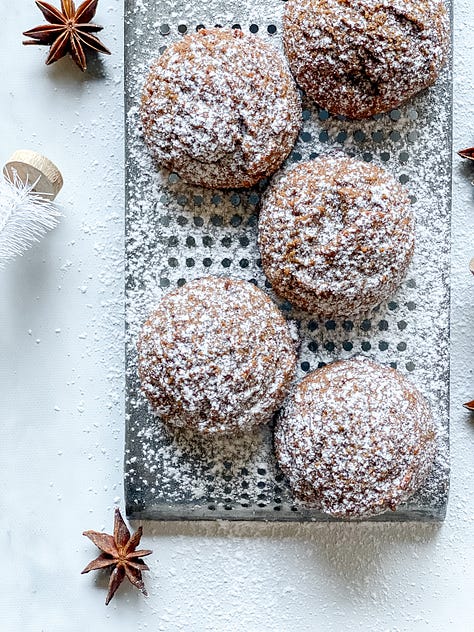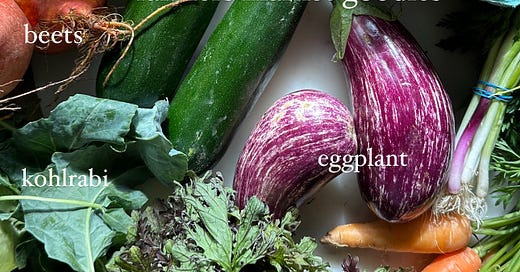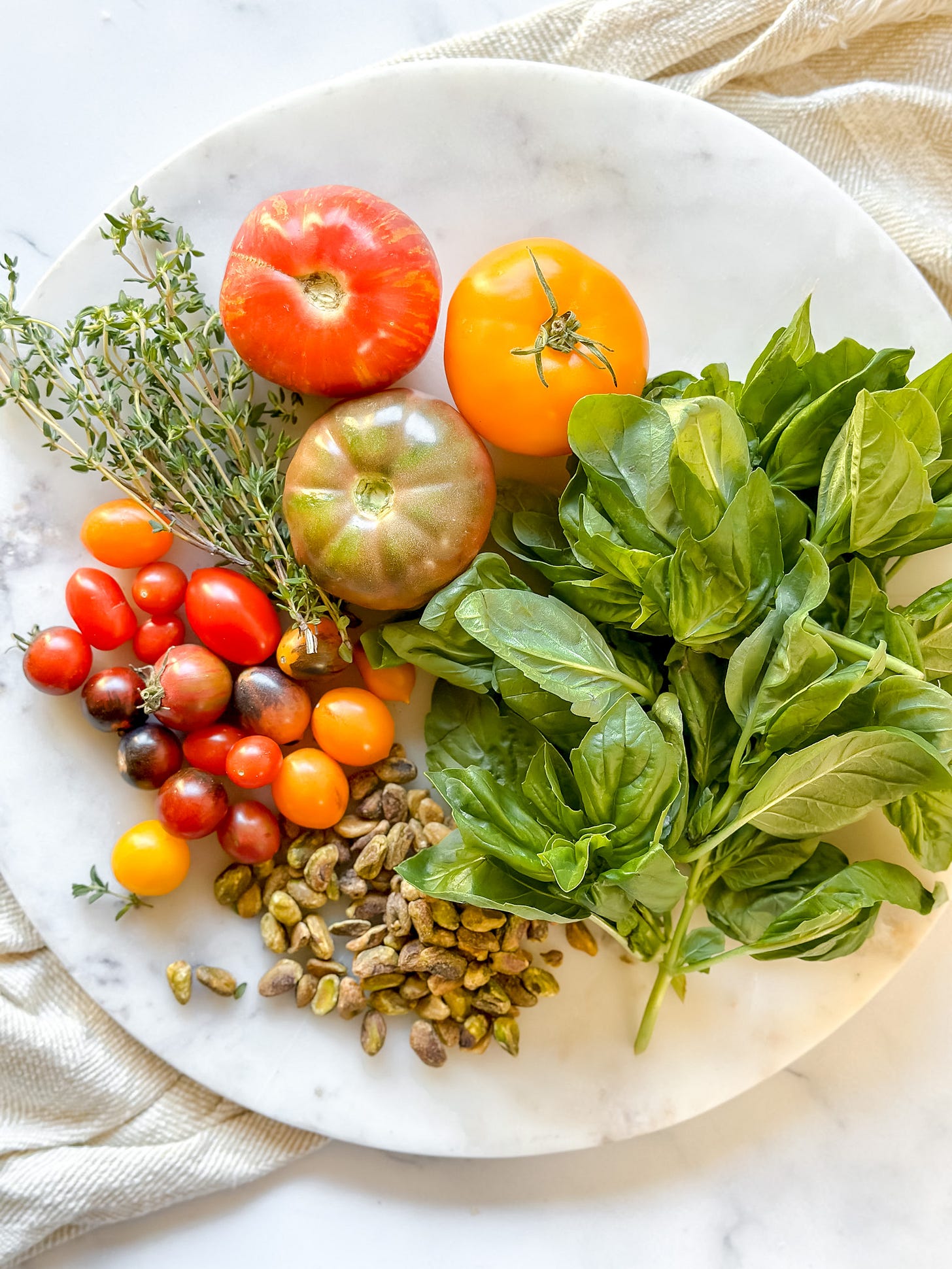Part 1: Real Food Made Simple
Building a Foundation for Metabolic Health, Blood Sugar Balance, and Healthy Aging
Learning to choose foods that nourish, protect, and energize our bodies
If you are ready to start replacing processed foods with more real, unprocessed ingredients and focus on a healthier lifestyle, welcome! This guide, part one of my Real Food Made Simple 3-part series, is all about making the shift toward real food easier and more enjoyable.
Moving toward a real food lifestyle might feel overwhelming. There’s a lot of information, and it’s tempting to change everything all at once. But meaningful, lasting change is more likely to happen gradually. Taking small, manageable steps over time allows your body—and your family—to adjust, building habits that stick. Here are some simple first steps to help you begin your journey to real food living, metabolic health, and vibrant aging. Pick one or two to start, and add more as you feel ready!
Our long-term goals are to: eliminate refined sugar, eliminate refined grains, eliminate factory-made fats, and make the great majority of what you eat whole, real food that will nourish, protect, and energize you and all the cells of your body!
What is whole, real food? Whole, real foods are foods that are as close to their natural form as possible, minimally processed, and free from artificial additives, preservatives, food dyes, and added sugars. They come directly from nature and have undergone minimal or no industrial processing, retaining their original nutrients, flavors, and textures.
Whole foods generally do not have a long list of ingredients and can be single ingredients themselves—like fruits, vegetables, nuts, seeds, beans, eggs, meat, and fish. Real, whole food can also be simply processed items like canned or jarred tomato sauce without added factory-made oils or sugar. Real, whole food also includes yogurt with live, active cultures and without added sugar. In this category, I also include convenience items like frozen berries and vegetables, canned coconut milk, spice mixes, and sauce mixes made with minimal ingredients without added sugar or factory-made fats and oils.
Real, whole food supports metabolic health, blood sugar balance, and overall wellness by providing essential vitamins, minerals, fiber, healthy fats, and protein without the harmful additives or excess sugars commonly found in processed foods. In essence, whole, real foods are as close as possible to how you would find them in nature or how your great-grandmother would have made them, making them nutrient-dense and beneficial for long-term health.
Pick one or two of the following ideas to start, and add more as you feel ready!
1. Swap Coffee Creamers
Coffee creamers are traditionally loaded with sugar, factory-made fats and oils, artificial flavors and colors, preservatives, and other ingredients that do not support metabolic health. A better choice? Milk or cream if you tolerate dairy, unsweetened nut milks like those from Elmhurst or Malk, or Nut pods if you don’t tolerate dairy. Or make your own flavored creamer like this easy Pumpkin Spice Creamer or this Easy Dairy Free Eggnog.
2. Replace Margarine with Butter
Swapping margarine for butter is a simple but powerful step toward eating real food. Butter contains only cream (and sometimes salt), whereas margarine is often packed with factory-made fats and oils, emulsifiers, and artificial additives. Opting for butter not only brings you closer to real ingredients but also helps you steer clear of inflammatory oils that can affect your metabolic health and long-term wellness, and it just tastes better too!
3. Choose Olive Oil + Avocado Oil Over Vegetable and Canola Oils
Vegetable and canola oils are often promoted as “heart-healthy,” but they are highly processed, factory-made fats that are heated (and therefore contain AGEs or advanced glycation end products) and can promote inflammation, which can impact insulin resistance and metabolic health. Instead, choose olive oil, avocado oil, coconut oil, and ghee, which are closer to nature and offer nutritional benefits.
Olive oil, rich in monounsaturated fats, is perfect for salad dressings and cooking. Coconut oil, ghee, and avocado oil are great for baking or cooking. By switching to these healthier oils, you’ll reduce inflammation and support brain and metabolic health, keeping blood sugar levels more stable.
4. Reduce and Eventually Eliminate Refined Grains
Refined grains are grains that have been stripped of their fiber, making them act like pure sugar in the bloodstream. These include wheat flour, oatmeal, white rice, and the great majority of boxed crackers, baked goods, packaged cookies, cakes, donuts, and bagels.
Familiarize yourself with new, nutrient-dense flours like almond flour, oat fiber, tiger nut flour, lupin flour, and coconut flour. Whole-food flours are higher in fiber, which helps support blood sugar control and gives you longer-lasting energy. They also contain more nutrients like magnesium, which aids in metabolic health and stress management.
A note about Gluten-Free packaged foods: many are made with highly refined rice, oat, potato, and other high-glycemic flours. I would put the great majority of gluten-free packaged foods in the “highly processed” food category. I have eaten gluten-free for over 12 years without relying on these packaged foods, and you can too!
Some recipes using healthier flours to get you started:
Peanut butter kisses (free recipe)
Triple chocolate banana bread (free recipe)
Breakfast cookies (recipe for paid subscribers)
Apple or zucchini muffins (recipe for paid subscribers)
5. Increase Your Veggie Intake
Vegetables are foundational for any real food lifestyle. Packed with fiber, vitamins, and antioxidants, veggies play a huge role in blood sugar balance and support cellular health, which contributes to healthy aging. Start by adding one or two types of vegetables to every meal—aim for variety and try new vegetables regularly.
A great long-term goal is to eat 30 different plants each week. This includes vegetables, low-glycemic fruits, berries, herbs, spices, nuts, seeds, and legumes. This diversity helps cultivate a healthy gut microbiome, which has a positive impact on everything from metabolism to immunity and brain health. Experiment with different veggies to keep meals interesting and enjoyable for the whole family.
Some ideas to get you started:
Keep dinner simple- choose a protein and two veggies, as in these yummy recipes:
Miso glazed salmon, bok choy, and mushrooms (free recipe)
Lemon garlic chicken with green beans and cauliflower mash (free recipe courtesy of
)Meatloaf, broccoli, and cauliflower mash (free recipe)
Mediterranean baked white fish with artichokes, tomatoes, and olives (free recipe)
Thai chicken meatball soup (free recipe)
6. Ditch Soda and Juice
Soda and fruit juices are significant contributors to blood sugar spikes, unintended weight gain, and, over time, fatty liver disease. Replacing these with healthier options may feel challenging at first, especially if they’re a daily habit, but this elimination will make a huge difference in how you feel and in your health outcomes.
Replace soda, fruit juice, and sweet tea with no-sugar kombucha, sparkling water with lime, no-sugar electrolytes, or unsweetened herbal teas. These alternatives give you refreshing flavors and that bubbly sensation without the sugar overload. Eliminating soda and fruit juice will reduce sugar cravings, stabilize energy levels, and support long-term metabolic health.
7. Avoid Artificial Sweeteners and High Fructose Corn Syrup
Certain ingredients are best avoided when it comes to metabolic health. High fructose corn syrup and artificial sweeteners, often found in condiments, snacks, and dressings, can interfere with blood sugar balance and increase inflammation.
Reading ingredient labels is key here. Start choosing products without these additives, and look for condiments with minimal sugars—no more than 2 grams per serving. While this might seem tedious, it’s a worthwhile shift that supports metabolic balance and reduces your exposure to inflammatory ingredients.
8. Make More Snacks at Home
Store-bought snacks often contain refined sugars, refined grains, preservatives, artificial flavors, and food dyes and lack fiber. Preparing snacks at home gives you control over the ingredients and lets you pack in extra nutrients that store-bought versions lack. Most adults need 35+ grams of fiber per day so choosing higher fiber foods will help you to reach that goal.
Try easy, nutrient-dense options like energy balls, muffins made with almond or coconut flour, or sliced veggies with homemade hummus. Making snacks yourself provides better blood sugar stability, and you can also skip the refined grains and sugars. Home-prepped snacks provide steady energy and keep you and your family satisfied between meals.
Some ideas to get you started:
Snickerdoodle protein balls (free recipe)
Lemon blueberry muffins (free recipe)
Peanut butter cups (free recipe)
Garlic hummus (free recipe)
Olive tapenade (free recipe)
or choose simple raw nuts or olives - they make great snacks too!
9. Prioritize Protein and Healthy Fat at Breakfast
Breakfast is a great opportunity to switch to more protein and fat-rich options that support blood sugar stability and keep you energized. Traditional boxed cereals, bagels, oatmeal, or toast may be quick, but they don’t provide lasting energy, and they often lead to a mid-morning energy crash. Did you know that most adults need 25-30 grams of protein per meal?
Instead, experiment with breakfasts like eggs, protein pancakes, No Oats (grain-free oatmeal alternatives), Greek yogurt bowls with nuts and seeds, or a breakfast casserole packed with veggies. Starting your day with protein, healthy fats, and fiber will help you avoid blood sugar spikes and keep you focused and full for longer. Begin with one or two new breakfast options each week to ease the transition.
Breakfast prioritizing protein and healthy fat can look like:
Yogurt (unsweetened) with nuts, grain-free granola, and berries
Yogurt (unsweetened) with grated cucumber, basil seeds, and pepitas
Creamy baked eggs (free recipe)
2-3 eggs scrambled with cottage cheese and spinach
No Oats with kefir and warm water, topped with nut butter or chopped nuts and berries (free recipe)
Tofu scramble with bell pepper and black beans
Flax bread with avocado and poached eggs (free recipe)
Dinner leftovers! Who says breakfast has to be “breakfast” food? I have been known to have soup, dinner veggies with a couple of eggs, and even salmon and veggies for breakfast!
10. Carve Out Time for Cooking
Eating real food becomes much more sustainable when you set aside time for planning and preparation. Carving out even one afternoon or evening each week for meal prep can make a huge difference. This could include chopping vegetables, batch-cooking proteins, and prepping snacks.
Having nutritious, ready-to-eat foods available keeps you on track even when time is tight, or you’re tired. A well-stocked fridge can also help prevent turning to processed convenience foods that disrupt blood sugar balance. Try creating a weekly menu and prep list to simplify meal prep and take some of the stress out of cooking from scratch.
Use this 7-day Blood Sugar Friendly Meal Plan or take a peek at what Dr. B and I prep Sunday for Healthy Meals all week long.
11. Explore Real Food and the Grocery Store’s Outer Aisles
Most real food ingredients—like fresh produce, meats, and dairy—are found around the outer aisles of the grocery store. You’ll find whole, minimally processed foods in these areas, while the interior aisles tend to contain packaged and processed items.
As you shop, explore different sections to find nutrient-rich staples. Try involving your family by browsing for recipes together and selecting a new meal to cook each week. Bringing your family into meal planning and shopping can make the journey to real food fun and engaging, helping everyone feel more connected to what’s on their plate. I have always found that my kids are more likely to eat something that they have had a hand in making.
Each of these steps is a move toward a lifestyle that supports metabolic health, balances blood sugar, and promotes vibrant aging. The journey to eating real food is rewarding, but it’s also a learning process. As you adopt these practices, you may find that they begin to feel second nature. Embrace the changes one step at a time and celebrate each small victory—before long, eating real food will become a natural, nourishing part of your life. Try to enjoy the process!
Next week, I will outline part 2, a blueprint for eating real food, and in part 3, I will share the healthy items I have on auto-ship to make eating real, whole food that much easier.
More resources for you:
From my Kitchen to yours, unlock Metabolic Health with CGM-verified recipes
1// A couple of weeks ago, I shared that Dexcom had made the over-the-counter CGM Stelo easier to obtain. Now, another company has followed suit: Abbott has made their Lingo CGM available without a prescription. I use a freestyle libre CGM from Levels Health. The advantage of using Levels Health is the recipes that are in the app (my recipes!) along with access to lab testing, studies, blogs, nutrient deep dives, and an enormous data set. More choices are better; whichever route you choose, a CGM is a great tool for improving your metabolic health.
2// I have been doing a lot of cooking and baking recently in preparation for the metabolically healthy Thanksgiving Menu that I have prepared for paid subscribers. I am so excited to share the menu and a surprise collab with you as well. The Thanksgiving Menu will drop November 10th and will include a printable ebook of all the recipes along with individual links to just print single recipes. If you have been considering becoming a paid subscriber, now would be a great time! The holidays are a tricky time for blood sugar balance, and I have done the experimenting for you to be sure all of the holiday recipes (gluten-free, grain-free, refined sugar-free, and low glycemic) all produce a level glucose response.
3// With all of the baking I have been doing, I have been loving instant dry yeast by Anthony’s Goods. It is a very active, bubbly yeast and works well in keto croissants, monkey bread, cinnamon rolls, and pizza bread—all grain-free, blood-sugar-friendly recipes coming soon!
4// Speaking of Holiday baking… my Cookies and Sweet Treats ebook is on sale!
Holiday classics made healthier, just in time for the holidays!
15 low carb recipes that are blood sugar friendly and free of refined sugars and grains
Snowballs, Gingerbread, Cutout Cookies, Brownie Candy Cane Cookies, Pfeffernusse, Almond Crescents, Gingerbread Roll Cake with “cream” filling, Nokhodchi Puffs, Melomakarona, Peanut Butter Blossoms, Thumbprint Cookies, Ginger Cookies with White Chocolate and Peppermint, Peanut Butter Cookies, Pecan Pie Cookies and Marzipan






Ways to connect with me!
Instagram, my website, email, make an appointment for custom meal planning, become a founding member, and get a free 45-minute consult, or message me here on Substack!
Thank you🧡
This newsletter wouldn’t be possible without YOU! A huge THANK YOU to all who support my work here on Substack.
🧡P.S.
If you know someone with pre-diabetes, diabetes, PCOS, metabolic syndrome, or anyone eating for blood sugar balance, low carb, keto, grain-free, gluten-free, or just eating whole food for better health, will you forward my Substack to them? I would love it if you would share my page with a friend or restack to your notes. Thank you!
🧡Beth











You share important information. As a clinician I find that most of my clients will be overwhelmed with a list that long but will benefit from each of these points shared once weekly
Such a great article, Beth! Looking forward to parts 2 & 3!